Muscle Insider
New member
It is not an exaggeration when I say pull-ups are the best exercise of all time to train the back.
Even if you have access to every piece of gym equipment in the world, a simple pull-up bar will give you the best back workout possible.
Can't do a pull-up? Don't worry - its many variations, regressions, and progressions mean you can get an absolute killer back workout regardless of your fitness level.
So, to make sure you get what you came for, this article will walk you through every pull up variation there is, from beginner to advanced.
Table of Contents:
What Are Pull-Ups?
Major Muscle Groups Involved
How To Do A Pull-Up With Proper Form
Benefits Of Pull-Ups
5 Beginner Pull Up Variations
14 Advanced Pull Up Variations
FAQs
Find out why the pull-up is the one upper-body exercise you need to build a massive back!
What Are Pull-Ups?
Pull-ups are a compound upper body exercise consisting of grabbing a bar and pulling yourself up. Hence the term "pull up." But what seems like a pretty basic exercise is actually very deceiving.
A pull-up is an extremely challenging upper-body exercise that not many people can do, particularly with good form. Further, although they are simple in concept, they are highly effective at training multiple muscle groups simultaneously.
As mentioned above, they are perhaps the best back exercise you can do.
Are Pull Ups Hard?
Because pull-ups are bodyweight exercises, they will test your relative strength, AKA the measure of how strong you are compared to your size. As such, to succeed with pull-ups, you need to improve two things.
Your body weight or body composition. Pull-ups will be significantly more challenging if you carry extra weight around in the form of fat. Think of it like this; some people will add weight to their pull-ups to make them harder. You are doing that naturally when you have excess fat.
Your total upper body pulling strength. Even if you have barely any fat on you, you won't be pulling yourself up anywhere if you're not strong.
Because of these two variables, pull-ups can be used to improve strength, muscular endurance, and body composition.
What Are The Major Muscles Trained By Pull-Ups?
The pull-up will train every single pulling muscle in your upper body, including your back and biceps. In addition, your core will also get a crazy workout as it's engaged to help maintain stability.
Here's a quick list of what you're going to be training.
Lats
Traps
Rear Delts
Biceps
Core
How To Do A Pull Up Correctly
You need to use proper form to get the most out of each rep, just like any other exercise. While you'll probably find doing pull-ups with good form harder, they'll become easier with time as you gain muscle and strength.
How to do a Pull Up:
To do a pull-up, you will first need a pull-up bar. It can be a specific pull-up bar, a pull-up bar on a rack, or even a sturdy tree in times of need. Most people can access one, so this shouldn't be an issue.
Grab the bar with an overhand grip so that your hands are placed slightly wider than shoulder-width apart. It shouldn't be dramatic, but your arms should point up at a bit of an angle when in a hanging position. Be sure to wrap your hands around it and get a good grip.
Begin the movement in a dead-hanging position, hanging from the bar with no muscle activation. Tighten your core, and bring yourself into an active hanging position, drawing your scapula backward. An active hang puts you in the correct position to generate maximal power.
Pulling your scapula back should also make you lean back so that your chest points slightly upward. This is the correct position to provide every rep with as much bang as possible.
Brace your core, and pull yourself up by driving your elbows down and pulling the bar to your chest. Throughout the motion, your shoulders should remain back.
Continue pulling until your chin goes entirely over the bar. Hold for a quick second, and then allow your body to lower slowly.
3 Benefits Of Pull Ups
There are a ton of benefits of pull ups. In fact, I could spend all day talking about them but instead, I'm going to touch on a few of the big ones so you better understand why you should be doing them.
1) You Can Do Them Anywhere.
Pull-ups can be done just about anywhere with just your body weight and a bar, making them a vital exercise to train on the go. Even if you don't have access to a gym, you can get creative and use trees or other structures.
Considering how important pull ups are to building your back, you may even want to get one of these 7 Outdoor Pull Up Bars to ensure you're set up to do pull ups.
2) There are plenty Of Pull-Up Variations.
Anyone who says you can't improve muscular strength with bodyweight exercises has never read this article. There are a ton of variations, even horizontal pulling ones! Regardless of your fitness level, there's always a pull-up variation you can do.
3) You Focus On Body Composition.
As mentioned, improving your body composition is a surefire way to improve on pull-ups. It's also safer and easier to get down to a decent body weight before doing regular pull-ups.
Start with easier pull-up variations, progressing to a more advanced one as your strength and body composition improve.
5 Beginner Pull-Up Variations
These pull-up variations will start with the easiest and then get progressively harder. You'll want to start somewhere in this section if you can't do a full pull-up.
The instructions I went over for normal pull ups will give you a good foundation for every pull-up variation. Therefore, instead of providing start-to-finish instructions for each of the pull up variants, I'll simply discuss their differences from the standard version.
1) Lat Pulldown And Treadmill:
You might be thinking, how is using a treadmill and doing lat pulldowns a pull-up variation? The truth is: This is a perfect starting point for many people.
Having been in the fitness industry for years, I've seen our fair share of personal trainers trying to force their clients to do an exercise they just can't do. This helps no one, as it kills confidence and stalls progress. Instead, it's important to start within your current abilities rather than force something because you're "supposed to" do it.
If you're at a level where you can't even hold yourself on a bar, that's fine! You're much better off training the same muscles with the lat pulldown while you drop weight and gain strength. Walking or jogging on the treadmill is one option for weight loss, but any mode of cardio that works for you is great. Once you've got a few weeks of this variation under your belt, you can progress to machine pull-ups.
2) Machine Pull Ups:
Next on our list are machine pull-ups. A machine pull-up is a machine that has a pull-up bar attached to a weight tower. You can then fold down a support system for your body where you can kneel. This platform is attached to weights which offsets your total body weight.
These make doing pull-ups much easier as they essentially make you lighter. While these have a role to play in pull-up progressions, much better beginner pull-up variations are available. It's a common mistake to start using a pull-up machine and never stop. Instead, make it your goal to move off the pull-up machines as fast as possible.
Why?
Because your knees are planted on the pad, your body can't sway, eliminating your core involvement. You'll not only need to activate your core in later variations, but it's generally a good practice for both function and physique.
3) Australian Rows/Inverted Row:
Australian rows are similar to a pull-up in that you're hanging upside down from a bar, but your feet remain on the floor, and you'll pull at a ~45-degree angle.
These will teach you to control your body weight and prep you for your first regular pull-up. Mess around and use various grips such as:
Wide grip
Narrow grip
Overhand grip
Underhand grip
4) Jumping Pull-Ups/Negative Pull Ups:
Exactly what they sound like, jumping pull-ups can be used in conjunction with machine pull-ups.
Grab a pull-up bar with the same hand width as a traditional pull-up. When ready, you're going to jump as a way to help pull yourself up. Because of this, you will need a shorter pull-up bar or use a box of some sort as a platform.
Once you jump and pull yourself to the top position, hold yourself briefly before you let yourself down. Ideally, you will be able to extend the time you hold yourself.
When ready, you will want to slowly lengthen the time you hold yourself up to 5 seconds. As you come down, you will begin by doing a slow, controlled drop that gradually gets longer over time.
During your eccentric contraction on the way down, your muscles can produce more force, so it's easier to lower yourself than pull yourself up. More so, eccentric contraction is responsible for more significant muscle damage and, ultimately, building muscle.
5) Resistance Band Pull Ups:
Once you can easily knock out jumping pull-ups, move on to banded pull-up variations. These are the preferred assisted pull-up variation, as they still allow your body to hang freely.
Set up the resistance bands so that they are secure. You can then put your knees inside the loop or your foot, depending on the height of the bar and your band. I like to advise my clients to use just one foot.
14 Advanced Pull-Up Variations
The next progression after resistance band pull ups is a standard pull up. Once you do one pull-up, continue training until you can do 6+. Then, you can start messing around with some of the advanced variations.
Remember that you can do regular pull-ups alongside advanced pull-up variations. For example, depending on your training split, you could alternate styles weekly, or train pull-ups twice a week, using one variation one day and another one the second day.
1) Weighted Pull Ups:
Weighted pull-ups can be applied to a regular pull-up or any of the below exercises. Depending on your pull-up variation, using a kettlebell is the easiest way to add weight. The handle makes a natural loop that you can stick your foot through.
A more secure method, however, is using a dip belt. These look similar to a weight belt yet have a chain attached to the front. This design allows you to connect it to various weights, so you don't need to think about holding anything while training.
You could also use a weighted vest if you have one. And if you don't, head over to our article on the 9 Best Weighted Vests to grab one.
2) Different Grips:
You can also change up your grips on pull-ups and pull-up variations. Here are a few ways to change things up:
Use a close grip or narrow grip
Mixed grip. One hand uses an overhand grip, while the other arm uses an underhand grip
Wide grip
Neutral grip (if you have access to the right pull-up bar)
3) Chin Ups:
When discussing pull-ups vs chin ups, chin-ups are similar to pull-ups, yet you use a supinated grip (underhand grip with palms facing you), which changes the biomechanics. The shoulder joint comes out in front of the body and allows the use of your bicep.
We like chin-ups as they engage multiple muscle groups more than pull-ups due to the biceps. They're generally easier to do at first, so you can use these as a stepping stone or in conjunction with pull-ups.
4) Commando Pull Ups:
Commando pull-ups are an awesome advanced variation that involves grabbing the bar with one hand in front of the other.
From here, you'll lean back slightly farther than regular pull-ups as you pull your body up. You will need to guide your head to go either left or right of the bar. I like to alternate our head and hand positions regularly and evenly, allowing the body to train in every possible position.
5) Towel Pull Ups:
If you're looking for exercises to improve your grip strength, a towel pull-up is it.
Towel pull-ups are performed by throwing a towel over a pull-up bar so the two ends hang down on each side. Grab each end with one hand using a neutral grip. From here, you will just do a commando pull-up. Another variation is to use two towels and place them apart so that you can use a regular hand grip width.
Because of the added grip pull challenge, your forearms will be on fire as you knock out reps. These are very popular among some MMA and BBJ combat athletes as they need a strong grip strength to succeed.
Towel Pull Up Demo on YouTube
6) Clapping Pull Ups:
Clapping pull-ups are a form of ballistic exercise that require you to pull yourself up using an explosive pull.
Your pull should be powerful enough to propel your body up, let go of the bar and clap, catch the bar, and then lower yourself down.
Clapping Pull Up Demo in YouTube
7) Side Pull-Ups/Finger Pull Ups:
A one-sided pull-up starting position is the same as regular pull-ups. Retract your scapula and begin to pull your body up. However, you will pull your body up to one side instead of going straight up.
This pull-up variation aims to overload one arm so that it must lift most of your body weight. When doing these, there are two ways you can perform them:
Alternate between each rep. This will be the easier method
Do one side at a time. As there's no rest, these are exponentially harder.
If you want, you can use progressive overload for this pull-up variation with "finger" pull-ups. These are performed by basically taking away fingers on your support hand (non-lifting hand). Even though your hand is still holding the bar, moving a finger makes it significantly harder.
Continue to take away fingers until you're doing perfect one-sided pull-ups while the support hand is using just one or two fingers.
Side Pull Up Demo on YouTube
8) Archer Pull Ups:
Archer pull-ups are similar to a side pull-up but a bit more intense and look pretty badass. You'll start with an extra wider grip, but as you pull your body to one side, you will extend your support hand so that it straightens while the hand is on top of the bar, not holding it.
Your non-working arm only acts as a lever in this variation.
9) Typewriter Pull Ups:
Typewriter pull-ups are basically archer pull-ups that stay in the top position and go back and forth, side-to-side, like a typewriter.
Once you pull yourself up to one side, you will keep your body at the same height for the entirety of your set. While still up, pull your body to the other side and have your hands switch positions. Go back and forth for the desired reps.
One way to make these significantly harder is simply slowing the movement. Once these become relatively easy, focus on slowing down how long it takes to go from one side to the other.
Typewriter Pull Up Demo on YouTube
10) Head Bangers:
Head bangers are a great pull-up variation that isn't seen often since they require significant body strength and control. When doing these, start with an underhand grip at a natural width.
Pull yourself up to the top position and hold yourself. Instead of coming down, you'll extend your arms and push your body backward. Realistically, your body will likely lose some height as you push yourself out further. However, you want to try and mitigate this.
When ready, pull your body back closer to the bar. Continue this motion as long as possible. It almost looks like you're doing a barbell row standing straight up and in the middle of the air.
Head Bangers Demo on YouTube
11) L Pull Ups & Human Flag Pull Ups:
Human flag pull-ups, also known as front lever pull ups or pull-up rows, are another challenging pull-up variation not utilized enough. A front lever is when you can keep your body parallel to the ground and completely erect with only your arms holding on to a foundation.
It's incredibly challenging and requires a ton of body control. While that is your ultimate goal, you don't need to do a perfect front lever to do this pull-up variation.
Your primary focus is to get your torso as parallel as possible so that you are effectively doing a row. A good stepping stone is to first build to L sit pull ups, and work your way to a completely straight core.
12) Chest-to-bar Pull Ups:
Chest-to-bar pull-ups, sometimes known as explosive pull-ups, are usually used as a stepping stone to muscle-ups. Regardless, it's an awesome kipping pull up variation to include some build explosive power in your upper body and back.
The biomechanics are exactly like a regular pull-up. However, instead of pulling yourself up slowly, you will pull hard with an explosive pull to bring your body as high as possible. Your goal is to at least bring your sternum (nipple level) to the bar.
13) Muscle Ups:
Muscle-ups are the pinnacle of upper-body calisthenics. They require highly advanced levels of not just upper body strength but body control as well.
Muscle-ups are an explosive pull-up that first brings your body above the bar. Then, you transition your arm placement and "flip" them into a front dip position. Catch yourself and complete the dip by extending your arms straight.
Muscle Ups Demo on YouTube
14) One-Arm Pull Ups:
One-arm pull-ups are essentially your final goal of pull-ups. Not only must you lift your entire body with a one-arm pull-up, but you also have to balance your body in an unnatural position. Using the above side pull-up variations is the best way to reach this ability.
Using the finger method, take away more and more fingers so that one arm is lifting the vast majority of the weight.
One Arm Pull Up Demo on YouTube
Struggling with pull ups or looking for other options that work your back in a similar way? Check out our article on the 13 Best Pull Up Alternatives!
FAQs
In case I missed anything, let's answer some of the more frequently asked questions about pull-up variations.
What is the best width variation for pull-ups?
Shoulder-width grips is best for standard pull-ups. However, if you have shoulder issues, a neutral grip might be easier.
Which pull-up works the most muscles?
All of these variation will work your muscles differently, but the muscle-up would work the most muscles as it involves your core and triceps, shoulders, and chest during the dip above the bar.
What pull-up variation is best for lats?
Whatever variation you can do comfortably will be the best to grow your lats. The key is consistency and proper form, so don't bite off more than you can chew.
Should I do multiple variations of pull-ups?
If you have the strength to do more than one variation, you could alternate them throughout the week. For example, you could do higher reps of chin ups on Tuesdays and heavier, weighted pull-ups on Fridays.
Incorporate Pull-up Variations Into Your Training For A Massive Back
If I could pick just one upper-body exercise for our back, it would probably be the pull-up. You can do these just about anywhere. And combine that with the looooong path you must take before you can't make them hard enough, you will always have the means to improve.
Remember, your main goal is to always try to work toward doing harder variations or add weight. Do that, and you'll be amazed by the change in your back and strength!
Looking for additional help to master the pull up? Try our Ultimate Pull Up Progression Plan For Beginners! In need of a piece of equipment that will support your pull up goals? Check out these 7 Best Outdoor Pull Up Bars!
Our Top Pick
Weather-resistant, paint-chip and corrosion resistant with UV protection to maintain vibrant color. Bars for push-ups, pull-ups, sit-ups, chin-ups...
It is not an exaggeration when I say pull-ups are the best exercise of all time to train the back.
Even if you have access to every piece of gym equipment in the world, a simple pull-up bar will give you the best back workout possible.
Can't do a pull-up? Don't worry - its many variations, regressions, and progressions mean you can get an absolute killer back workout regardless of your fitness level.
So, to make sure you get what you came for, this article will walk you through every pull up variation there is, from beginner to advanced.
Table of Contents:
Find out why the pull-up is the one upper-body exercise you need to build a massive back!
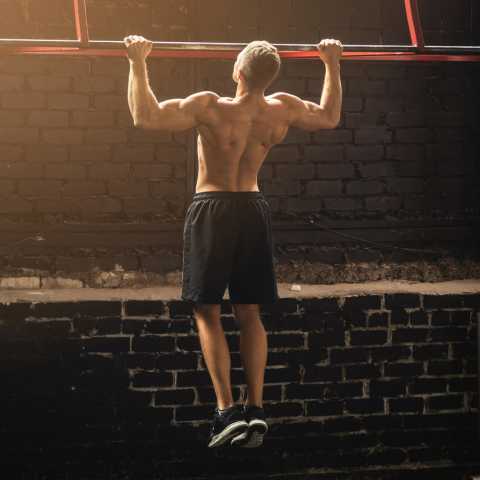
What Are Pull-Ups?
Pull-ups are a compound upper body exercise consisting of grabbing a bar and pulling yourself up. Hence the term "pull up." But what seems like a pretty basic exercise is actually very deceiving.
A pull-up is an extremely challenging upper-body exercise that not many people can do, particularly with good form. Further, although they are simple in concept, they are highly effective at training multiple muscle groups simultaneously.
As mentioned above, they are perhaps the best back exercise you can do.
Are Pull Ups Hard?
Because pull-ups are bodyweight exercises, they will test your relative strength, AKA the measure of how strong you are compared to your size. As such, to succeed with pull-ups, you need to improve two things.
[*]Your body weight or body composition. Pull-ups will be significantly more challenging if you carry extra weight around in the form of fat. Think of it like this; some people will add weight to their pull-ups to make them harder. You are doing that naturally when you have excess fat.
[*]Your total upper body pulling strength. Even if you have barely any fat on you, you won't be pulling yourself up anywhere if you're not strong.
Because of these two variables, pull-ups can be used to improve strength, muscular endurance, and body composition.
What Are The Major Muscles Trained By Pull-Ups?
The pull-up will train every single pulling muscle in your upper body, including your back and biceps. In addition, your core will also get a crazy workout as it's engaged to help maintain stability.
Here's a quick list of what you're going to be training.
How To Do A Pull Up Correctly
You need to use proper form to get the most out of each rep, just like any other exercise. While you'll probably find doing pull-ups with good form harder, they'll become easier with time as you gain muscle and strength.
How to do a Pull Up:
3 Benefits Of Pull Ups
There are a ton of benefits of pull ups. In fact, I could spend all day talking about them but instead, I'm going to touch on a few of the big ones so you better understand why you should be doing them.
1) You Can Do Them Anywhere.
Pull-ups can be done just about anywhere with just your body weight and a bar, making them a vital exercise to train on the go. Even if you don't have access to a gym, you can get creative and use trees or other structures.
Considering how important pull ups are to building your back, you may even want to get one of these 7 Outdoor Pull Up Bars to ensure you're set up to do pull ups.
2) There are plenty Of Pull-Up Variations.
Anyone who says you can't improve muscular strength with bodyweight exercises has never read this article. There are a ton of variations, even horizontal pulling ones! Regardless of your fitness level, there's always a pull-up variation you can do.
3) You Focus On Body Composition.
As mentioned, improving your body composition is a surefire way to improve on pull-ups. It's also safer and easier to get down to a decent body weight before doing regular pull-ups.
Start with easier pull-up variations, progressing to a more advanced one as your strength and body composition improve.
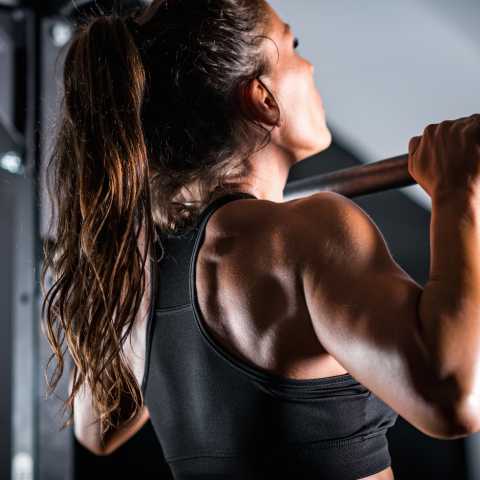
5 Beginner Pull-Up Variations
These pull-up variations will start with the easiest and then get progressively harder. You'll want to start somewhere in this section if you can't do a full pull-up.
The instructions I went over for normal pull ups will give you a good foundation for every pull-up variation. Therefore, instead of providing start-to-finish instructions for each of the pull up variants, I'll simply discuss their differences from the standard version.
1) Lat Pulldown And Treadmill:

You might be thinking, how is using a treadmill and doing lat pulldowns a pull-up variation? The truth is: This is a perfect starting point for many people.
Having been in the fitness industry for years, I've seen our fair share of personal trainers trying to force their clients to do an exercise they just can't do. This helps no one, as it kills confidence and stalls progress. Instead, it's important to start within your current abilities rather than force something because you're "supposed to" do it.
If you're at a level where you can't even hold yourself on a bar, that's fine! You're much better off training the same muscles with the lat pulldown while you drop weight and gain strength. Walking or jogging on the treadmill is one option for weight loss, but any mode of cardio that works for you is great. Once you've got a few weeks of this variation under your belt, you can progress to machine pull-ups.
2) Machine Pull Ups:

Next on our list are machine pull-ups. A machine pull-up is a machine that has a pull-up bar attached to a weight tower. You can then fold down a support system for your body where you can kneel. This platform is attached to weights which offsets your total body weight.
These make doing pull-ups much easier as they essentially make you lighter. While these have a role to play in pull-up progressions, much better beginner pull-up variations are available. It's a common mistake to start using a pull-up machine and never stop. Instead, make it your goal to move off the pull-up machines as fast as possible.
Why?
Because your knees are planted on the pad, your body can't sway, eliminating your core involvement. You'll not only need to activate your core in later variations, but it's generally a good practice for both function and physique.
3) Australian Rows/Inverted Row:
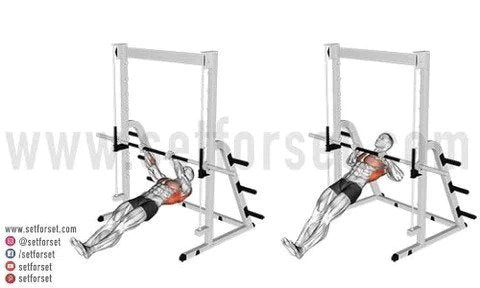
Australian rows are similar to a pull-up in that you're hanging upside down from a bar, but your feet remain on the floor, and you'll pull at a ~45-degree angle.
These will teach you to control your body weight and prep you for your first regular pull-up. Mess around and use various grips such as:
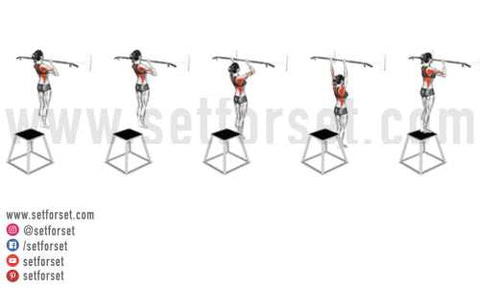
Exactly what they sound like, jumping pull-ups can be used in conjunction with machine pull-ups.
Grab a pull-up bar with the same hand width as a traditional pull-up. When ready, you're going to jump as a way to help pull yourself up. Because of this, you will need a shorter pull-up bar or use a box of some sort as a platform.
Once you jump and pull yourself to the top position, hold yourself briefly before you let yourself down. Ideally, you will be able to extend the time you hold yourself.
When ready, you will want to slowly lengthen the time you hold yourself up to 5 seconds. As you come down, you will begin by doing a slow, controlled drop that gradually gets longer over time.
During your eccentric contraction on the way down, your muscles can produce more force, so it's easier to lower yourself than pull yourself up. More so, eccentric contraction is responsible for more significant muscle damage and, ultimately, building muscle.
5) Resistance Band Pull Ups:
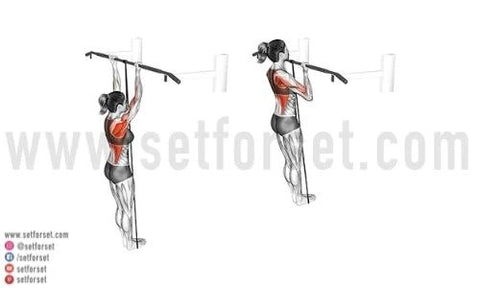
Once you can easily knock out jumping pull-ups, move on to banded pull-up variations. These are the preferred assisted pull-up variation, as they still allow your body to hang freely.
Set up the resistance bands so that they are secure. You can then put your knees inside the loop or your foot, depending on the height of the bar and your band. I like to advise my clients to use just one foot.
14 Advanced Pull-Up Variations
The next progression after resistance band pull ups is a standard pull up. Once you do one pull-up, continue training until you can do 6+. Then, you can start messing around with some of the advanced variations.
Remember that you can do regular pull-ups alongside advanced pull-up variations. For example, depending on your training split, you could alternate styles weekly, or train pull-ups twice a week, using one variation one day and another one the second day.
1) Weighted Pull Ups:
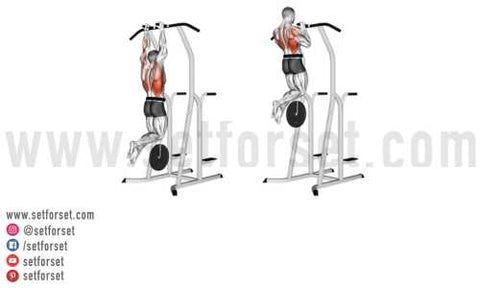
Weighted pull-ups can be applied to a regular pull-up or any of the below exercises. Depending on your pull-up variation, using a kettlebell is the easiest way to add weight. The handle makes a natural loop that you can stick your foot through.
A more secure method, however, is using a dip belt. These look similar to a weight belt yet have a chain attached to the front. This design allows you to connect it to various weights, so you don't need to think about holding anything while training.
You could also use a weighted vest if you have one. And if you don't, head over to our article on the 9 Best Weighted Vests to grab one.
2) Different Grips:
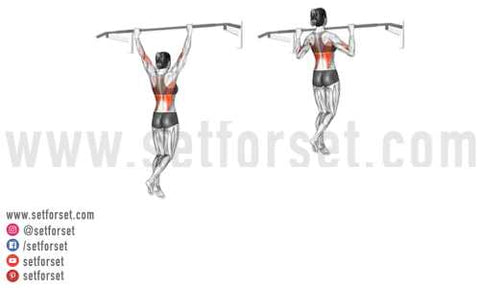
You can also change up your grips on pull-ups and pull-up variations. Here are a few ways to change things up:
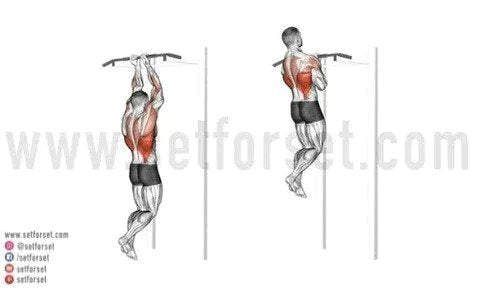
When discussing pull-ups vs chin ups, chin-ups are similar to pull-ups, yet you use a supinated grip (underhand grip with palms facing you), which changes the biomechanics. The shoulder joint comes out in front of the body and allows the use of your bicep.
We like chin-ups as they engage multiple muscle groups more than pull-ups due to the biceps. They're generally easier to do at first, so you can use these as a stepping stone or in conjunction with pull-ups.
4) Commando Pull Ups:
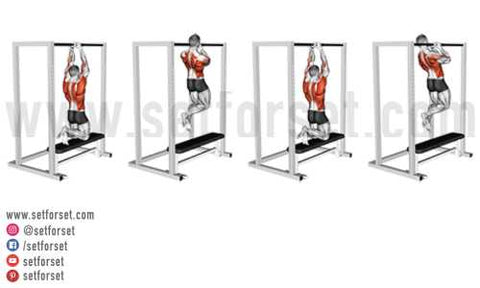
Commando pull-ups are an awesome advanced variation that involves grabbing the bar with one hand in front of the other.
From here, you'll lean back slightly farther than regular pull-ups as you pull your body up. You will need to guide your head to go either left or right of the bar. I like to alternate our head and hand positions regularly and evenly, allowing the body to train in every possible position.
5) Towel Pull Ups:
If you're looking for exercises to improve your grip strength, a towel pull-up is it.
Towel pull-ups are performed by throwing a towel over a pull-up bar so the two ends hang down on each side. Grab each end with one hand using a neutral grip. From here, you will just do a commando pull-up. Another variation is to use two towels and place them apart so that you can use a regular hand grip width.
Because of the added grip pull challenge, your forearms will be on fire as you knock out reps. These are very popular among some MMA and BBJ combat athletes as they need a strong grip strength to succeed.
Towel Pull Up Demo on YouTube
6) Clapping Pull Ups:
Clapping pull-ups are a form of ballistic exercise that require you to pull yourself up using an explosive pull.
Your pull should be powerful enough to propel your body up, let go of the bar and clap, catch the bar, and then lower yourself down.
Clapping Pull Up Demo in YouTube
7) Side Pull-Ups/Finger Pull Ups:
A one-sided pull-up starting position is the same as regular pull-ups. Retract your scapula and begin to pull your body up. However, you will pull your body up to one side instead of going straight up.
This pull-up variation aims to overload one arm so that it must lift most of your body weight. When doing these, there are two ways you can perform them:
[*]Alternate between each rep. This will be the easier method
[*]Do one side at a time. As there's no rest, these are exponentially harder.
If you want, you can use progressive overload for this pull-up variation with "finger" pull-ups. These are performed by basically taking away fingers on your support hand (non-lifting hand). Even though your hand is still holding the bar, moving a finger makes it significantly harder.
Continue to take away fingers until you're doing perfect one-sided pull-ups while the support hand is using just one or two fingers.
Side Pull Up Demo on YouTube
8) Archer Pull Ups:

Archer pull-ups are similar to a side pull-up but a bit more intense and look pretty badass. You'll start with an extra wider grip, but as you pull your body to one side, you will extend your support hand so that it straightens while the hand is on top of the bar, not holding it.
Your non-working arm only acts as a lever in this variation.
9) Typewriter Pull Ups:
Typewriter pull-ups are basically archer pull-ups that stay in the top position and go back and forth, side-to-side, like a typewriter.
Once you pull yourself up to one side, you will keep your body at the same height for the entirety of your set. While still up, pull your body to the other side and have your hands switch positions. Go back and forth for the desired reps.
One way to make these significantly harder is simply slowing the movement. Once these become relatively easy, focus on slowing down how long it takes to go from one side to the other.
Typewriter Pull Up Demo on YouTube
10) Head Bangers:
Head bangers are a great pull-up variation that isn't seen often since they require significant body strength and control. When doing these, start with an underhand grip at a natural width.
Pull yourself up to the top position and hold yourself. Instead of coming down, you'll extend your arms and push your body backward. Realistically, your body will likely lose some height as you push yourself out further. However, you want to try and mitigate this.
When ready, pull your body back closer to the bar. Continue this motion as long as possible. It almost looks like you're doing a barbell row standing straight up and in the middle of the air.
Head Bangers Demo on YouTube
11) L Pull Ups & Human Flag Pull Ups:
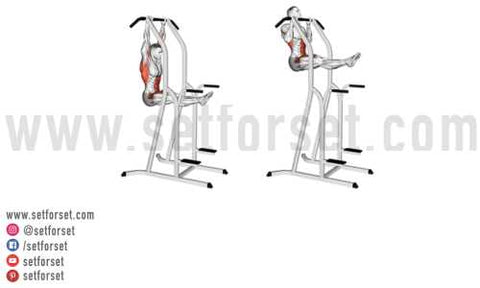
Human flag pull-ups, also known as front lever pull ups or pull-up rows, are another challenging pull-up variation not utilized enough. A front lever is when you can keep your body parallel to the ground and completely erect with only your arms holding on to a foundation.
It's incredibly challenging and requires a ton of body control. While that is your ultimate goal, you don't need to do a perfect front lever to do this pull-up variation.
Your primary focus is to get your torso as parallel as possible so that you are effectively doing a row. A good stepping stone is to first build to L sit pull ups, and work your way to a completely straight core.
12) Chest-to-bar Pull Ups:
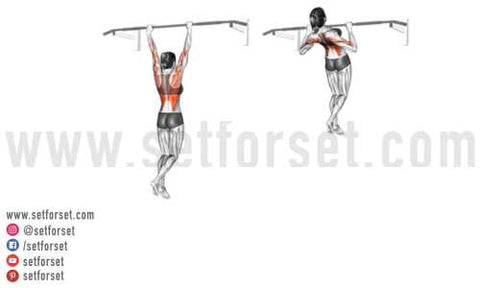
Chest-to-bar pull-ups, sometimes known as explosive pull-ups, are usually used as a stepping stone to muscle-ups. Regardless, it's an awesome kipping pull up variation to include some build explosive power in your upper body and back.
The biomechanics are exactly like a regular pull-up. However, instead of pulling yourself up slowly, you will pull hard with an explosive pull to bring your body as high as possible. Your goal is to at least bring your sternum (nipple level) to the bar.
13) Muscle Ups:
Muscle-ups are the pinnacle of upper-body calisthenics. They require highly advanced levels of not just upper body strength but body control as well.
Muscle-ups are an explosive pull-up that first brings your body above the bar. Then, you transition your arm placement and "flip" them into a front dip position. Catch yourself and complete the dip by extending your arms straight.
Muscle Ups Demo on YouTube
14) One-Arm Pull Ups:
One-arm pull-ups are essentially your final goal of pull-ups. Not only must you lift your entire body with a one-arm pull-up, but you also have to balance your body in an unnatural position. Using the above side pull-up variations is the best way to reach this ability.
Using the finger method, take away more and more fingers so that one arm is lifting the vast majority of the weight.
One Arm Pull Up Demo on YouTube
Struggling with pull ups or looking for other options that work your back in a similar way? Check out our article on the 13 Best Pull Up Alternatives!

FAQs
In case I missed anything, let's answer some of the more frequently asked questions about pull-up variations.
What is the best width variation for pull-ups?
Shoulder-width grips is best for standard pull-ups. However, if you have shoulder issues, a neutral grip might be easier.
Which pull-up works the most muscles?
All of these variation will work your muscles differently, but the muscle-up would work the most muscles as it involves your core and triceps, shoulders, and chest during the dip above the bar.
What pull-up variation is best for lats?
Whatever variation you can do comfortably will be the best to grow your lats. The key is consistency and proper form, so don't bite off more than you can chew.
Should I do multiple variations of pull-ups?
If you have the strength to do more than one variation, you could alternate them throughout the week. For example, you could do higher reps of chin ups on Tuesdays and heavier, weighted pull-ups on Fridays.
Incorporate Pull-up Variations Into Your Training For A Massive Back
If I could pick just one upper-body exercise for our back, it would probably be the pull-up. You can do these just about anywhere. And combine that with the looooong path you must take before you can't make them hard enough, you will always have the means to improve.
Remember, your main goal is to always try to work toward doing harder variations or add weight. Do that, and you'll be amazed by the change in your back and strength!
Looking for additional help to master the pull up? Try our Ultimate Pull Up Progression Plan For Beginners! In need of a piece of equipment that will support your pull up goals? Check out these 7 Best Outdoor Pull Up Bars!
Our Top Pick
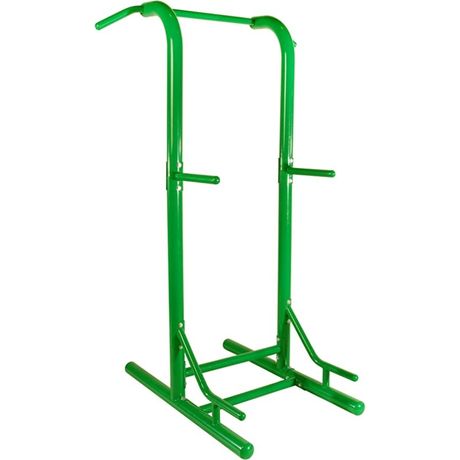
Weather-resistant, paint-chip and corrosion resistant with UV protection to maintain vibrant color. Bars for push-ups, pull-ups, sit-ups, chin-ups...
Click here to view the article.
Even if you have access to every piece of gym equipment in the world, a simple pull-up bar will give you the best back workout possible.
Can't do a pull-up? Don't worry - its many variations, regressions, and progressions mean you can get an absolute killer back workout regardless of your fitness level.
So, to make sure you get what you came for, this article will walk you through every pull up variation there is, from beginner to advanced.
Table of Contents:
What Are Pull-Ups?
Major Muscle Groups Involved
How To Do A Pull-Up With Proper Form
Benefits Of Pull-Ups
5 Beginner Pull Up Variations
14 Advanced Pull Up Variations
FAQs
Find out why the pull-up is the one upper-body exercise you need to build a massive back!
What Are Pull-Ups?
Pull-ups are a compound upper body exercise consisting of grabbing a bar and pulling yourself up. Hence the term "pull up." But what seems like a pretty basic exercise is actually very deceiving.
A pull-up is an extremely challenging upper-body exercise that not many people can do, particularly with good form. Further, although they are simple in concept, they are highly effective at training multiple muscle groups simultaneously.
As mentioned above, they are perhaps the best back exercise you can do.
Are Pull Ups Hard?
Because pull-ups are bodyweight exercises, they will test your relative strength, AKA the measure of how strong you are compared to your size. As such, to succeed with pull-ups, you need to improve two things.
Your body weight or body composition. Pull-ups will be significantly more challenging if you carry extra weight around in the form of fat. Think of it like this; some people will add weight to their pull-ups to make them harder. You are doing that naturally when you have excess fat.
Your total upper body pulling strength. Even if you have barely any fat on you, you won't be pulling yourself up anywhere if you're not strong.
Because of these two variables, pull-ups can be used to improve strength, muscular endurance, and body composition.
What Are The Major Muscles Trained By Pull-Ups?
The pull-up will train every single pulling muscle in your upper body, including your back and biceps. In addition, your core will also get a crazy workout as it's engaged to help maintain stability.
Here's a quick list of what you're going to be training.
Lats
Traps
Rear Delts
Biceps
Core
How To Do A Pull Up Correctly
You need to use proper form to get the most out of each rep, just like any other exercise. While you'll probably find doing pull-ups with good form harder, they'll become easier with time as you gain muscle and strength.
How to do a Pull Up:
To do a pull-up, you will first need a pull-up bar. It can be a specific pull-up bar, a pull-up bar on a rack, or even a sturdy tree in times of need. Most people can access one, so this shouldn't be an issue.
Grab the bar with an overhand grip so that your hands are placed slightly wider than shoulder-width apart. It shouldn't be dramatic, but your arms should point up at a bit of an angle when in a hanging position. Be sure to wrap your hands around it and get a good grip.
Begin the movement in a dead-hanging position, hanging from the bar with no muscle activation. Tighten your core, and bring yourself into an active hanging position, drawing your scapula backward. An active hang puts you in the correct position to generate maximal power.
Pulling your scapula back should also make you lean back so that your chest points slightly upward. This is the correct position to provide every rep with as much bang as possible.
Brace your core, and pull yourself up by driving your elbows down and pulling the bar to your chest. Throughout the motion, your shoulders should remain back.
Continue pulling until your chin goes entirely over the bar. Hold for a quick second, and then allow your body to lower slowly.
3 Benefits Of Pull Ups
There are a ton of benefits of pull ups. In fact, I could spend all day talking about them but instead, I'm going to touch on a few of the big ones so you better understand why you should be doing them.
1) You Can Do Them Anywhere.
Pull-ups can be done just about anywhere with just your body weight and a bar, making them a vital exercise to train on the go. Even if you don't have access to a gym, you can get creative and use trees or other structures.
Considering how important pull ups are to building your back, you may even want to get one of these 7 Outdoor Pull Up Bars to ensure you're set up to do pull ups.
2) There are plenty Of Pull-Up Variations.
Anyone who says you can't improve muscular strength with bodyweight exercises has never read this article. There are a ton of variations, even horizontal pulling ones! Regardless of your fitness level, there's always a pull-up variation you can do.
3) You Focus On Body Composition.
As mentioned, improving your body composition is a surefire way to improve on pull-ups. It's also safer and easier to get down to a decent body weight before doing regular pull-ups.
Start with easier pull-up variations, progressing to a more advanced one as your strength and body composition improve.
5 Beginner Pull-Up Variations
These pull-up variations will start with the easiest and then get progressively harder. You'll want to start somewhere in this section if you can't do a full pull-up.
The instructions I went over for normal pull ups will give you a good foundation for every pull-up variation. Therefore, instead of providing start-to-finish instructions for each of the pull up variants, I'll simply discuss their differences from the standard version.
1) Lat Pulldown And Treadmill:
You might be thinking, how is using a treadmill and doing lat pulldowns a pull-up variation? The truth is: This is a perfect starting point for many people.
Having been in the fitness industry for years, I've seen our fair share of personal trainers trying to force their clients to do an exercise they just can't do. This helps no one, as it kills confidence and stalls progress. Instead, it's important to start within your current abilities rather than force something because you're "supposed to" do it.
If you're at a level where you can't even hold yourself on a bar, that's fine! You're much better off training the same muscles with the lat pulldown while you drop weight and gain strength. Walking or jogging on the treadmill is one option for weight loss, but any mode of cardio that works for you is great. Once you've got a few weeks of this variation under your belt, you can progress to machine pull-ups.
2) Machine Pull Ups:
Next on our list are machine pull-ups. A machine pull-up is a machine that has a pull-up bar attached to a weight tower. You can then fold down a support system for your body where you can kneel. This platform is attached to weights which offsets your total body weight.
These make doing pull-ups much easier as they essentially make you lighter. While these have a role to play in pull-up progressions, much better beginner pull-up variations are available. It's a common mistake to start using a pull-up machine and never stop. Instead, make it your goal to move off the pull-up machines as fast as possible.
Why?
Because your knees are planted on the pad, your body can't sway, eliminating your core involvement. You'll not only need to activate your core in later variations, but it's generally a good practice for both function and physique.
3) Australian Rows/Inverted Row:
Australian rows are similar to a pull-up in that you're hanging upside down from a bar, but your feet remain on the floor, and you'll pull at a ~45-degree angle.
These will teach you to control your body weight and prep you for your first regular pull-up. Mess around and use various grips such as:
Wide grip
Narrow grip
Overhand grip
Underhand grip
4) Jumping Pull-Ups/Negative Pull Ups:
Exactly what they sound like, jumping pull-ups can be used in conjunction with machine pull-ups.
Grab a pull-up bar with the same hand width as a traditional pull-up. When ready, you're going to jump as a way to help pull yourself up. Because of this, you will need a shorter pull-up bar or use a box of some sort as a platform.
Once you jump and pull yourself to the top position, hold yourself briefly before you let yourself down. Ideally, you will be able to extend the time you hold yourself.
When ready, you will want to slowly lengthen the time you hold yourself up to 5 seconds. As you come down, you will begin by doing a slow, controlled drop that gradually gets longer over time.
During your eccentric contraction on the way down, your muscles can produce more force, so it's easier to lower yourself than pull yourself up. More so, eccentric contraction is responsible for more significant muscle damage and, ultimately, building muscle.
5) Resistance Band Pull Ups:
Once you can easily knock out jumping pull-ups, move on to banded pull-up variations. These are the preferred assisted pull-up variation, as they still allow your body to hang freely.
Set up the resistance bands so that they are secure. You can then put your knees inside the loop or your foot, depending on the height of the bar and your band. I like to advise my clients to use just one foot.
14 Advanced Pull-Up Variations
The next progression after resistance band pull ups is a standard pull up. Once you do one pull-up, continue training until you can do 6+. Then, you can start messing around with some of the advanced variations.
Remember that you can do regular pull-ups alongside advanced pull-up variations. For example, depending on your training split, you could alternate styles weekly, or train pull-ups twice a week, using one variation one day and another one the second day.
1) Weighted Pull Ups:
Weighted pull-ups can be applied to a regular pull-up or any of the below exercises. Depending on your pull-up variation, using a kettlebell is the easiest way to add weight. The handle makes a natural loop that you can stick your foot through.
A more secure method, however, is using a dip belt. These look similar to a weight belt yet have a chain attached to the front. This design allows you to connect it to various weights, so you don't need to think about holding anything while training.
You could also use a weighted vest if you have one. And if you don't, head over to our article on the 9 Best Weighted Vests to grab one.
2) Different Grips:
You can also change up your grips on pull-ups and pull-up variations. Here are a few ways to change things up:
Use a close grip or narrow grip
Mixed grip. One hand uses an overhand grip, while the other arm uses an underhand grip
Wide grip
Neutral grip (if you have access to the right pull-up bar)
3) Chin Ups:
When discussing pull-ups vs chin ups, chin-ups are similar to pull-ups, yet you use a supinated grip (underhand grip with palms facing you), which changes the biomechanics. The shoulder joint comes out in front of the body and allows the use of your bicep.
We like chin-ups as they engage multiple muscle groups more than pull-ups due to the biceps. They're generally easier to do at first, so you can use these as a stepping stone or in conjunction with pull-ups.
4) Commando Pull Ups:
Commando pull-ups are an awesome advanced variation that involves grabbing the bar with one hand in front of the other.
From here, you'll lean back slightly farther than regular pull-ups as you pull your body up. You will need to guide your head to go either left or right of the bar. I like to alternate our head and hand positions regularly and evenly, allowing the body to train in every possible position.
5) Towel Pull Ups:
If you're looking for exercises to improve your grip strength, a towel pull-up is it.
Towel pull-ups are performed by throwing a towel over a pull-up bar so the two ends hang down on each side. Grab each end with one hand using a neutral grip. From here, you will just do a commando pull-up. Another variation is to use two towels and place them apart so that you can use a regular hand grip width.
Because of the added grip pull challenge, your forearms will be on fire as you knock out reps. These are very popular among some MMA and BBJ combat athletes as they need a strong grip strength to succeed.
Towel Pull Up Demo on YouTube
6) Clapping Pull Ups:
Clapping pull-ups are a form of ballistic exercise that require you to pull yourself up using an explosive pull.
Your pull should be powerful enough to propel your body up, let go of the bar and clap, catch the bar, and then lower yourself down.
Clapping Pull Up Demo in YouTube
7) Side Pull-Ups/Finger Pull Ups:
A one-sided pull-up starting position is the same as regular pull-ups. Retract your scapula and begin to pull your body up. However, you will pull your body up to one side instead of going straight up.
This pull-up variation aims to overload one arm so that it must lift most of your body weight. When doing these, there are two ways you can perform them:
Alternate between each rep. This will be the easier method
Do one side at a time. As there's no rest, these are exponentially harder.
If you want, you can use progressive overload for this pull-up variation with "finger" pull-ups. These are performed by basically taking away fingers on your support hand (non-lifting hand). Even though your hand is still holding the bar, moving a finger makes it significantly harder.
Continue to take away fingers until you're doing perfect one-sided pull-ups while the support hand is using just one or two fingers.
Side Pull Up Demo on YouTube
8) Archer Pull Ups:
Archer pull-ups are similar to a side pull-up but a bit more intense and look pretty badass. You'll start with an extra wider grip, but as you pull your body to one side, you will extend your support hand so that it straightens while the hand is on top of the bar, not holding it.
Your non-working arm only acts as a lever in this variation.
9) Typewriter Pull Ups:
Typewriter pull-ups are basically archer pull-ups that stay in the top position and go back and forth, side-to-side, like a typewriter.
Once you pull yourself up to one side, you will keep your body at the same height for the entirety of your set. While still up, pull your body to the other side and have your hands switch positions. Go back and forth for the desired reps.
One way to make these significantly harder is simply slowing the movement. Once these become relatively easy, focus on slowing down how long it takes to go from one side to the other.
Typewriter Pull Up Demo on YouTube
10) Head Bangers:
Head bangers are a great pull-up variation that isn't seen often since they require significant body strength and control. When doing these, start with an underhand grip at a natural width.
Pull yourself up to the top position and hold yourself. Instead of coming down, you'll extend your arms and push your body backward. Realistically, your body will likely lose some height as you push yourself out further. However, you want to try and mitigate this.
When ready, pull your body back closer to the bar. Continue this motion as long as possible. It almost looks like you're doing a barbell row standing straight up and in the middle of the air.
Head Bangers Demo on YouTube
11) L Pull Ups & Human Flag Pull Ups:
Human flag pull-ups, also known as front lever pull ups or pull-up rows, are another challenging pull-up variation not utilized enough. A front lever is when you can keep your body parallel to the ground and completely erect with only your arms holding on to a foundation.
It's incredibly challenging and requires a ton of body control. While that is your ultimate goal, you don't need to do a perfect front lever to do this pull-up variation.
Your primary focus is to get your torso as parallel as possible so that you are effectively doing a row. A good stepping stone is to first build to L sit pull ups, and work your way to a completely straight core.
12) Chest-to-bar Pull Ups:
Chest-to-bar pull-ups, sometimes known as explosive pull-ups, are usually used as a stepping stone to muscle-ups. Regardless, it's an awesome kipping pull up variation to include some build explosive power in your upper body and back.
The biomechanics are exactly like a regular pull-up. However, instead of pulling yourself up slowly, you will pull hard with an explosive pull to bring your body as high as possible. Your goal is to at least bring your sternum (nipple level) to the bar.
13) Muscle Ups:
Muscle-ups are the pinnacle of upper-body calisthenics. They require highly advanced levels of not just upper body strength but body control as well.
Muscle-ups are an explosive pull-up that first brings your body above the bar. Then, you transition your arm placement and "flip" them into a front dip position. Catch yourself and complete the dip by extending your arms straight.
Muscle Ups Demo on YouTube
14) One-Arm Pull Ups:
One-arm pull-ups are essentially your final goal of pull-ups. Not only must you lift your entire body with a one-arm pull-up, but you also have to balance your body in an unnatural position. Using the above side pull-up variations is the best way to reach this ability.
Using the finger method, take away more and more fingers so that one arm is lifting the vast majority of the weight.
One Arm Pull Up Demo on YouTube
Struggling with pull ups or looking for other options that work your back in a similar way? Check out our article on the 13 Best Pull Up Alternatives!
FAQs
In case I missed anything, let's answer some of the more frequently asked questions about pull-up variations.
What is the best width variation for pull-ups?
Shoulder-width grips is best for standard pull-ups. However, if you have shoulder issues, a neutral grip might be easier.
Which pull-up works the most muscles?
All of these variation will work your muscles differently, but the muscle-up would work the most muscles as it involves your core and triceps, shoulders, and chest during the dip above the bar.
What pull-up variation is best for lats?
Whatever variation you can do comfortably will be the best to grow your lats. The key is consistency and proper form, so don't bite off more than you can chew.
Should I do multiple variations of pull-ups?
If you have the strength to do more than one variation, you could alternate them throughout the week. For example, you could do higher reps of chin ups on Tuesdays and heavier, weighted pull-ups on Fridays.
Incorporate Pull-up Variations Into Your Training For A Massive Back
If I could pick just one upper-body exercise for our back, it would probably be the pull-up. You can do these just about anywhere. And combine that with the looooong path you must take before you can't make them hard enough, you will always have the means to improve.
Remember, your main goal is to always try to work toward doing harder variations or add weight. Do that, and you'll be amazed by the change in your back and strength!
Looking for additional help to master the pull up? Try our Ultimate Pull Up Progression Plan For Beginners! In need of a piece of equipment that will support your pull up goals? Check out these 7 Best Outdoor Pull Up Bars!
Our Top Pick
Weather-resistant, paint-chip and corrosion resistant with UV protection to maintain vibrant color. Bars for push-ups, pull-ups, sit-ups, chin-ups...
It is not an exaggeration when I say pull-ups are the best exercise of all time to train the back.
Even if you have access to every piece of gym equipment in the world, a simple pull-up bar will give you the best back workout possible.
Can't do a pull-up? Don't worry - its many variations, regressions, and progressions mean you can get an absolute killer back workout regardless of your fitness level.
So, to make sure you get what you came for, this article will walk you through every pull up variation there is, from beginner to advanced.
Table of Contents:
- What Are Pull-Ups?
- Major Muscle Groups Involved
- How To Do A Pull-Up With Proper Form
- Benefits Of Pull-Ups
- 5 Beginner Pull Up Variations
- 14 Advanced Pull Up Variations
- FAQs
Find out why the pull-up is the one upper-body exercise you need to build a massive back!

What Are Pull-Ups?
Pull-ups are a compound upper body exercise consisting of grabbing a bar and pulling yourself up. Hence the term "pull up." But what seems like a pretty basic exercise is actually very deceiving.
A pull-up is an extremely challenging upper-body exercise that not many people can do, particularly with good form. Further, although they are simple in concept, they are highly effective at training multiple muscle groups simultaneously.
As mentioned above, they are perhaps the best back exercise you can do.
Are Pull Ups Hard?
Because pull-ups are bodyweight exercises, they will test your relative strength, AKA the measure of how strong you are compared to your size. As such, to succeed with pull-ups, you need to improve two things.
[*]Your body weight or body composition. Pull-ups will be significantly more challenging if you carry extra weight around in the form of fat. Think of it like this; some people will add weight to their pull-ups to make them harder. You are doing that naturally when you have excess fat.
[*]Your total upper body pulling strength. Even if you have barely any fat on you, you won't be pulling yourself up anywhere if you're not strong.
Because of these two variables, pull-ups can be used to improve strength, muscular endurance, and body composition.
What Are The Major Muscles Trained By Pull-Ups?
The pull-up will train every single pulling muscle in your upper body, including your back and biceps. In addition, your core will also get a crazy workout as it's engaged to help maintain stability.
Here's a quick list of what you're going to be training.
- Lats
- Traps
- Rear Delts
- Biceps
- Core
How To Do A Pull Up Correctly
You need to use proper form to get the most out of each rep, just like any other exercise. While you'll probably find doing pull-ups with good form harder, they'll become easier with time as you gain muscle and strength.
How to do a Pull Up:
- To do a pull-up, you will first need a pull-up bar. It can be a specific pull-up bar, a pull-up bar on a rack, or even a sturdy tree in times of need. Most people can access one, so this shouldn't be an issue.
- Grab the bar with an overhand grip so that your hands are placed slightly wider than shoulder-width apart. It shouldn't be dramatic, but your arms should point up at a bit of an angle when in a hanging position. Be sure to wrap your hands around it and get a good grip.
- Begin the movement in a dead-hanging position, hanging from the bar with no muscle activation. Tighten your core, and bring yourself into an active hanging position, drawing your scapula backward. An active hang puts you in the correct position to generate maximal power.
- Pulling your scapula back should also make you lean back so that your chest points slightly upward. This is the correct position to provide every rep with as much bang as possible.
- Brace your core, and pull yourself up by driving your elbows down and pulling the bar to your chest. Throughout the motion, your shoulders should remain back.
- Continue pulling until your chin goes entirely over the bar. Hold for a quick second, and then allow your body to lower slowly.
3 Benefits Of Pull Ups
There are a ton of benefits of pull ups. In fact, I could spend all day talking about them but instead, I'm going to touch on a few of the big ones so you better understand why you should be doing them.
1) You Can Do Them Anywhere.
Pull-ups can be done just about anywhere with just your body weight and a bar, making them a vital exercise to train on the go. Even if you don't have access to a gym, you can get creative and use trees or other structures.
Considering how important pull ups are to building your back, you may even want to get one of these 7 Outdoor Pull Up Bars to ensure you're set up to do pull ups.
2) There are plenty Of Pull-Up Variations.
Anyone who says you can't improve muscular strength with bodyweight exercises has never read this article. There are a ton of variations, even horizontal pulling ones! Regardless of your fitness level, there's always a pull-up variation you can do.
3) You Focus On Body Composition.
As mentioned, improving your body composition is a surefire way to improve on pull-ups. It's also safer and easier to get down to a decent body weight before doing regular pull-ups.
Start with easier pull-up variations, progressing to a more advanced one as your strength and body composition improve.

5 Beginner Pull-Up Variations
These pull-up variations will start with the easiest and then get progressively harder. You'll want to start somewhere in this section if you can't do a full pull-up.
The instructions I went over for normal pull ups will give you a good foundation for every pull-up variation. Therefore, instead of providing start-to-finish instructions for each of the pull up variants, I'll simply discuss their differences from the standard version.
1) Lat Pulldown And Treadmill:

You might be thinking, how is using a treadmill and doing lat pulldowns a pull-up variation? The truth is: This is a perfect starting point for many people.
Having been in the fitness industry for years, I've seen our fair share of personal trainers trying to force their clients to do an exercise they just can't do. This helps no one, as it kills confidence and stalls progress. Instead, it's important to start within your current abilities rather than force something because you're "supposed to" do it.
If you're at a level where you can't even hold yourself on a bar, that's fine! You're much better off training the same muscles with the lat pulldown while you drop weight and gain strength. Walking or jogging on the treadmill is one option for weight loss, but any mode of cardio that works for you is great. Once you've got a few weeks of this variation under your belt, you can progress to machine pull-ups.
2) Machine Pull Ups:

Next on our list are machine pull-ups. A machine pull-up is a machine that has a pull-up bar attached to a weight tower. You can then fold down a support system for your body where you can kneel. This platform is attached to weights which offsets your total body weight.
These make doing pull-ups much easier as they essentially make you lighter. While these have a role to play in pull-up progressions, much better beginner pull-up variations are available. It's a common mistake to start using a pull-up machine and never stop. Instead, make it your goal to move off the pull-up machines as fast as possible.
Why?
Because your knees are planted on the pad, your body can't sway, eliminating your core involvement. You'll not only need to activate your core in later variations, but it's generally a good practice for both function and physique.
3) Australian Rows/Inverted Row:

Australian rows are similar to a pull-up in that you're hanging upside down from a bar, but your feet remain on the floor, and you'll pull at a ~45-degree angle.
These will teach you to control your body weight and prep you for your first regular pull-up. Mess around and use various grips such as:
- Wide grip
- Narrow grip
- Overhand grip
- Underhand grip

Exactly what they sound like, jumping pull-ups can be used in conjunction with machine pull-ups.
Grab a pull-up bar with the same hand width as a traditional pull-up. When ready, you're going to jump as a way to help pull yourself up. Because of this, you will need a shorter pull-up bar or use a box of some sort as a platform.
Once you jump and pull yourself to the top position, hold yourself briefly before you let yourself down. Ideally, you will be able to extend the time you hold yourself.
When ready, you will want to slowly lengthen the time you hold yourself up to 5 seconds. As you come down, you will begin by doing a slow, controlled drop that gradually gets longer over time.
During your eccentric contraction on the way down, your muscles can produce more force, so it's easier to lower yourself than pull yourself up. More so, eccentric contraction is responsible for more significant muscle damage and, ultimately, building muscle.
5) Resistance Band Pull Ups:

Once you can easily knock out jumping pull-ups, move on to banded pull-up variations. These are the preferred assisted pull-up variation, as they still allow your body to hang freely.
Set up the resistance bands so that they are secure. You can then put your knees inside the loop or your foot, depending on the height of the bar and your band. I like to advise my clients to use just one foot.
14 Advanced Pull-Up Variations
The next progression after resistance band pull ups is a standard pull up. Once you do one pull-up, continue training until you can do 6+. Then, you can start messing around with some of the advanced variations.
Remember that you can do regular pull-ups alongside advanced pull-up variations. For example, depending on your training split, you could alternate styles weekly, or train pull-ups twice a week, using one variation one day and another one the second day.
1) Weighted Pull Ups:

Weighted pull-ups can be applied to a regular pull-up or any of the below exercises. Depending on your pull-up variation, using a kettlebell is the easiest way to add weight. The handle makes a natural loop that you can stick your foot through.
A more secure method, however, is using a dip belt. These look similar to a weight belt yet have a chain attached to the front. This design allows you to connect it to various weights, so you don't need to think about holding anything while training.
You could also use a weighted vest if you have one. And if you don't, head over to our article on the 9 Best Weighted Vests to grab one.
2) Different Grips:

You can also change up your grips on pull-ups and pull-up variations. Here are a few ways to change things up:
- Use a close grip or narrow grip
- Mixed grip. One hand uses an overhand grip, while the other arm uses an underhand grip
- Wide grip
- Neutral grip (if you have access to the right pull-up bar)

When discussing pull-ups vs chin ups, chin-ups are similar to pull-ups, yet you use a supinated grip (underhand grip with palms facing you), which changes the biomechanics. The shoulder joint comes out in front of the body and allows the use of your bicep.
We like chin-ups as they engage multiple muscle groups more than pull-ups due to the biceps. They're generally easier to do at first, so you can use these as a stepping stone or in conjunction with pull-ups.
4) Commando Pull Ups:

Commando pull-ups are an awesome advanced variation that involves grabbing the bar with one hand in front of the other.
From here, you'll lean back slightly farther than regular pull-ups as you pull your body up. You will need to guide your head to go either left or right of the bar. I like to alternate our head and hand positions regularly and evenly, allowing the body to train in every possible position.
5) Towel Pull Ups:
If you're looking for exercises to improve your grip strength, a towel pull-up is it.
Towel pull-ups are performed by throwing a towel over a pull-up bar so the two ends hang down on each side. Grab each end with one hand using a neutral grip. From here, you will just do a commando pull-up. Another variation is to use two towels and place them apart so that you can use a regular hand grip width.
Because of the added grip pull challenge, your forearms will be on fire as you knock out reps. These are very popular among some MMA and BBJ combat athletes as they need a strong grip strength to succeed.
Towel Pull Up Demo on YouTube
6) Clapping Pull Ups:
Clapping pull-ups are a form of ballistic exercise that require you to pull yourself up using an explosive pull.
Your pull should be powerful enough to propel your body up, let go of the bar and clap, catch the bar, and then lower yourself down.
Clapping Pull Up Demo in YouTube
7) Side Pull-Ups/Finger Pull Ups:
A one-sided pull-up starting position is the same as regular pull-ups. Retract your scapula and begin to pull your body up. However, you will pull your body up to one side instead of going straight up.
This pull-up variation aims to overload one arm so that it must lift most of your body weight. When doing these, there are two ways you can perform them:
[*]Alternate between each rep. This will be the easier method
[*]Do one side at a time. As there's no rest, these are exponentially harder.
If you want, you can use progressive overload for this pull-up variation with "finger" pull-ups. These are performed by basically taking away fingers on your support hand (non-lifting hand). Even though your hand is still holding the bar, moving a finger makes it significantly harder.
Continue to take away fingers until you're doing perfect one-sided pull-ups while the support hand is using just one or two fingers.
Side Pull Up Demo on YouTube
8) Archer Pull Ups:

Archer pull-ups are similar to a side pull-up but a bit more intense and look pretty badass. You'll start with an extra wider grip, but as you pull your body to one side, you will extend your support hand so that it straightens while the hand is on top of the bar, not holding it.
Your non-working arm only acts as a lever in this variation.
9) Typewriter Pull Ups:
Typewriter pull-ups are basically archer pull-ups that stay in the top position and go back and forth, side-to-side, like a typewriter.
Once you pull yourself up to one side, you will keep your body at the same height for the entirety of your set. While still up, pull your body to the other side and have your hands switch positions. Go back and forth for the desired reps.
One way to make these significantly harder is simply slowing the movement. Once these become relatively easy, focus on slowing down how long it takes to go from one side to the other.
Typewriter Pull Up Demo on YouTube
10) Head Bangers:
Head bangers are a great pull-up variation that isn't seen often since they require significant body strength and control. When doing these, start with an underhand grip at a natural width.
Pull yourself up to the top position and hold yourself. Instead of coming down, you'll extend your arms and push your body backward. Realistically, your body will likely lose some height as you push yourself out further. However, you want to try and mitigate this.
When ready, pull your body back closer to the bar. Continue this motion as long as possible. It almost looks like you're doing a barbell row standing straight up and in the middle of the air.
Head Bangers Demo on YouTube
11) L Pull Ups & Human Flag Pull Ups:

Human flag pull-ups, also known as front lever pull ups or pull-up rows, are another challenging pull-up variation not utilized enough. A front lever is when you can keep your body parallel to the ground and completely erect with only your arms holding on to a foundation.
It's incredibly challenging and requires a ton of body control. While that is your ultimate goal, you don't need to do a perfect front lever to do this pull-up variation.
Your primary focus is to get your torso as parallel as possible so that you are effectively doing a row. A good stepping stone is to first build to L sit pull ups, and work your way to a completely straight core.
12) Chest-to-bar Pull Ups:

Chest-to-bar pull-ups, sometimes known as explosive pull-ups, are usually used as a stepping stone to muscle-ups. Regardless, it's an awesome kipping pull up variation to include some build explosive power in your upper body and back.
The biomechanics are exactly like a regular pull-up. However, instead of pulling yourself up slowly, you will pull hard with an explosive pull to bring your body as high as possible. Your goal is to at least bring your sternum (nipple level) to the bar.
13) Muscle Ups:
Muscle-ups are the pinnacle of upper-body calisthenics. They require highly advanced levels of not just upper body strength but body control as well.
Muscle-ups are an explosive pull-up that first brings your body above the bar. Then, you transition your arm placement and "flip" them into a front dip position. Catch yourself and complete the dip by extending your arms straight.
Muscle Ups Demo on YouTube
14) One-Arm Pull Ups:
One-arm pull-ups are essentially your final goal of pull-ups. Not only must you lift your entire body with a one-arm pull-up, but you also have to balance your body in an unnatural position. Using the above side pull-up variations is the best way to reach this ability.
Using the finger method, take away more and more fingers so that one arm is lifting the vast majority of the weight.
One Arm Pull Up Demo on YouTube
Struggling with pull ups or looking for other options that work your back in a similar way? Check out our article on the 13 Best Pull Up Alternatives!

FAQs
In case I missed anything, let's answer some of the more frequently asked questions about pull-up variations.
What is the best width variation for pull-ups?
Shoulder-width grips is best for standard pull-ups. However, if you have shoulder issues, a neutral grip might be easier.
Which pull-up works the most muscles?
All of these variation will work your muscles differently, but the muscle-up would work the most muscles as it involves your core and triceps, shoulders, and chest during the dip above the bar.
What pull-up variation is best for lats?
Whatever variation you can do comfortably will be the best to grow your lats. The key is consistency and proper form, so don't bite off more than you can chew.
Should I do multiple variations of pull-ups?
If you have the strength to do more than one variation, you could alternate them throughout the week. For example, you could do higher reps of chin ups on Tuesdays and heavier, weighted pull-ups on Fridays.
Incorporate Pull-up Variations Into Your Training For A Massive Back
If I could pick just one upper-body exercise for our back, it would probably be the pull-up. You can do these just about anywhere. And combine that with the looooong path you must take before you can't make them hard enough, you will always have the means to improve.
Remember, your main goal is to always try to work toward doing harder variations or add weight. Do that, and you'll be amazed by the change in your back and strength!
Looking for additional help to master the pull up? Try our Ultimate Pull Up Progression Plan For Beginners! In need of a piece of equipment that will support your pull up goals? Check out these 7 Best Outdoor Pull Up Bars!
Our Top Pick

Weather-resistant, paint-chip and corrosion resistant with UV protection to maintain vibrant color. Bars for push-ups, pull-ups, sit-ups, chin-ups...
Click here to view the article.









